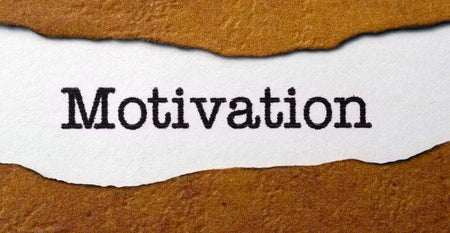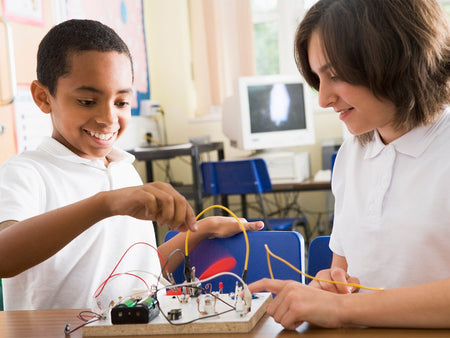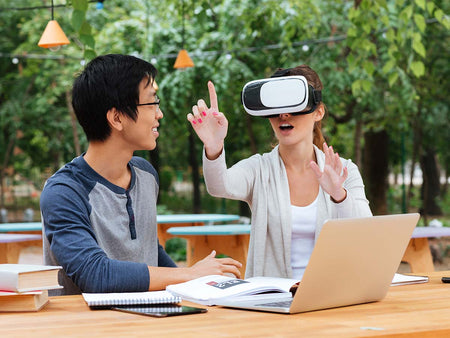Student Learning

Much of our lesson planning time and energy is spent figuring out how best to motivate students to learn. We know that even the best content and crucial academic skills can go unlearned unless students are motivated. We also know that the best learning motivation comes from within students, not in response to external incentives and consequences attached to whether students choose to learn.
Of course, some learning inherently is interesting, meaningful, and attractive for students. Known as intrinsic motivation, this drive to learn is commonly generated by one or more of the following conditions:
Students feel confident in their ability to succeed.
Students see their actions as directly contributing to an outcome.
Students find value or are interested in what they’re learning.
Students expect the learning effort they’re giving will lead to a sense of belonging or approval.
So, what might these conditions look like in practice? Consider these five research supported examples to generate even more possibilities.
It benefits students to see that what they’re learning is important or fun. The keys are for learning to be purposeful and to keep the focus on learning benefits, not grades. If students perceive learning as fun, adding dimensions to make it even more fun enhances the learning experience. Interestingly, according to research, if students see learning as important, adding a dimension of fun has little positive impact on their learning.
Encourage students to share their best learning strategies and advice with another student to create learning advantages. Students often find getting advice from another student easier and more comfortable than from an adult. Surprisingly, studies show the greatest impact from students sharing advice can be on the student who shares the advice.
Coach students to engage in productive self-talk. For example, students can remind themselves that they’re capable, competent, and creative and can recall past successful situations. Also, students may remind themselves of the consequences for not completing an assignment or feeling disappointment if they fail in their work.
Another way is to encourage students to set up routines and organize their immediate environment to create a state of mental readiness and reduce interruptions. For example, students choose to follow consistent steps as they organize study materials, put away distractions, and get ready to focus. They also may establish consistent locations where they study. The consistency of preparation and location makes getting started easier as it becomes the next step of a familiar routine in a comfortable space. For extended learning sessions, having more than one location to shift to after an hour or so creates a motivating enhancement.
Finally, we can give students procedural and cognitive choices. In contrast to organizational choices, such as choosing where to sit or what partners with whom to work, procedural choices invite students to decide how they’ll approach an assignment or display their learning. Cognitive choices extend to strategies students will use to engage in their work, prior learning and skills they’ll employ, and what processes they’ll use to solve a problem. While organizational choices provide students a sense of belonging, procedural choices generate early motivation for students to get started and cognitive choices generate interest, ownership, and commitment to learning activities.
We know each student arrives with different needs, interests, and aspirations. The more we know about them the better able we’re to design experiences and present learning tasks they’ll find motivating. However, our long-term goal needs to be for students to recognize how they can motivate themselves. These five research-based strategies are a great place for them to start.
Sources:
Sparks, S. (2022, April 24). 3 Counterintuitive findings about motivation that teachers can use. Education Week.
Stefanou, C. R., Perencevich, K. C., DiCintio, M., & Turner, J. C. (2004). Supporting autonomy in the classroom: Ways teachers encourage student decision making and ownership. Educational Psychologist, 39(2), 97–110. https://doi.org/10.1207/s15326985ep3902_2

Help Students Learn Faster and Remember Longer
Our immediate goal with each lesson is to have students absorb content they encounter and build skills with which they’re presented. We want them to be successful today. However, our larger, longer-term goal is to have them become skilled, efficient, and effective learners. Students building skills and developing techniques equip them to learn faster and remember more of what they learn.
When we teach and coach students to develop effective learning skills and habits, we support them to be more successful today. We also equip them with tools and techniques they can employ long after they leave our classrooms, creating long-term investment in and contributing to their success.
This is a good time of year to introduce and review some of these tools and approaches. We can re-energize our students by giving them additional insights and advantages to accelerate learning and build stronger, longer lasting recall of what they learn. Consider these five tools and techniques to share.
One of the best ways to help students organize and make sense of new learning is have them summarize and explain their understanding and observations to someone. The activity can be as simple as a brief “turn and talk,” or as formal as doing a stand-up presentation or developing a set of “how to” instructions. The process of transforming newly absorbed information into an explanation solidifies new learning and the process of sharing new learning helps transfer it into memory. If students study alone and there's no one immediately present with whom they can share their learning, they'll benefit by verbalizing what they learn or by writing a summary to solidify their understanding. Of course, summarizing and sharing learning also may reveal misconceptions and misunderstandings that can be addressed before they become embedded in memory.
Another way to accelerate and solidify new learning is for students to practice frequent self-quizzing. Coaching students to pause frequently as they read new content or engage in a developing skill encourages them to ask themselves questions and test their growing knowledge. Like explaining or summarizing new learning, self-quizzing moves information from “intake” to “ownership” in students’ brains. As a result, newly acquired information more quickly becomes embedded in memory allowing gaps in information and understanding to be uncovered and addressed.
Yet another strategy to help students efficiently build new learning and store it in memory is to have them space out and vary learning and practice sessions. Lengthy and intense practice sessions may seem like a good way to build understanding and automaticity in learning, but the strategy can also result in exhaustion and leave students not recalling key information. Alternatively, when learning a new skill or absorbing new content is spaced over multiple sessions attention remains fresh, and focus is easier to maintain. Further, when students vary their study processes and practice activities, learning becomes layered and varied. Consequently, it’s easier to retain and retrieve.
Still, another strategy to improve and accelerate learning is to have students include multiple skills or concepts within the same learning or study session. For example, students might study math and chemistry in the same session, mix new information with review of past learning, or address content out of chronological order. Known as interleaving, the process of addressing multiple concepts or skills in succession keeps the brain alert and improves its ability to differentiate elements and aspects of the content students are learning. Their brain is required to adjust and adapt, thus building depth and detail in what students learn.
Finally, we can help students develop confidence and readiness to continue learning by coaching and reminding them to pay attention to and celebrate their learning successes, even when they may seem small. Students often are tempted to focus on and remember their struggles and failures. However, when students celebrate even small wins, they stimulate a feel-good chemical in their brains known as dopamine. The feeling generated by dopamine reinforces the learning experience and leaves students wanting more. Further, giving attention to successes can build learning confidence as students prepare to engage in the next learning challenge.
Learning often is hard, and finding the necessary energy and confidence to struggle and succeed can be challenging. We need to provide our students with the very best tools and techniques available. These five research and practice-proven approaches provide valuable additions to our students’ learning “tool chests.” Consider setting aside time in the coming week to introduce and have students tryout some of these learning tools and reap their benefits.

When Students Say, “I Tried, but I Can’t Learn It.”
Students who’ve tried to learn a new concept or skill and have been unsuccessful often complain they’re not capable of learning what we ask. Their observations may be couched in statements, such as “I am just not good at…”— insert math, science, or another discipline. Or “My mother wasn’t good at learning this, so there’s no point in trying.”
These observations reflect symptoms of students who experience low levels of academic self-efficacy. Their perception is that trying to learn something and not being successful proves their inability to learn. Yet, the cause is more likely to be an ineffective strategy, an unproductive effort, or a failure to make full use of resources that would assist the student in the learning process.
Left unaddressed, these students may go through much of their lives believing they lack ability when what they lack are correct tools for learning support. Efficacious learners understand that when they attempt new learning and are unsuccessful, they likely can change the outcome by employing three key learning tools: strategy, effort, and resources.
We can help students become more effective learners by coaching them to review the strategy they’re using and consider more worthwhile alternatives. We can explore with learners the nature of the effort they’re giving and how other approaches might be more successful. Finally, we can direct the attention of students toward available resources that might be helpful to their understanding and support their learning.
Our discussion with students about learning strategies might include examples, such as:
- Reading new content and taking notes for later review.
- Listening to new content while simultaneously reading it.
- Focusing on the big picture or general concept and then sorting details and exploring implications and applications.
- Breaking down content or skills into parts and focusing on sections.
- Self-testing occasionally to confirm and consolidate understanding.
- Looking for connections with what has been previously learned.
- Creating pictures or graphs to understand connections and relationships.
- Explaining new content to others as it is learned.
- Sustaining extended periods of focus and persistence.
- Giving intermittent focus followed by brief breaks for reflection.
- Engaging in intense study followed by other, unrelated activities, and returning later to refresh and extend learning.
- Spacing practice over multiple days to build recall.
- Shifting physical locations while studying to employ context to assist memory.
- Scheduling study sessions during optimal times of the day when energy levels are highest.
- Consulting fellow students who’ve already learned the content or skill for explanation and learning hints.
- Watching online videos that provide explanation and practice opportunities.
- Reviewing varied text explanations that provide different perspectives.
- Exploring graphic representations of content or skills.
- Reviewing and reflecting on examples of applications for new learning.

Slow Down - Accomplish More
Educators tend to be conscientious professionals. We want to do our jobs well. We want to be successful. We want to meet our own and others’ expectations. These desires can drive us to constantly try to not only do more things but do them faster and longer. Unfortunately, the secret to creating satisfaction and experiencing success is not found in how fast, how hard, and how long we work.
We might think that we create momentum by pushing hard, going fast, and engaging in frenetic activity. Yet, the path to satisfaction, success, and serenity is not paved by doing more and doing more faster and longer. Just as much as slowing down doesn’t mean “quiet quitting” or giving up. Slowing down is accomplished by becoming clear about what is important to us, focusing on our goals, and being willing to say no. It’s about letting go of what doesn't move us in the direction we’ve chosen.
Yet, the thought of slowing down may leave us uncomfortable and anxious. We’re conditioned to equate activity with productivity, but they’re not the same and don’t lead to the same result. We may think if we slow down, we’ll be seen as uncommitted, unconcerned, and uncaring. Yet, the opposite is more likely to be correct. If we really want to make a difference, serve the needs of our students, and build a career of which we can be proud, we need to be focused, not frenetic, and strategic, not scattered, in the constant building of our skills.
Let’s examine six outcomes we can generate by slowing our thinking and moderating our pace:
- Slowing down our thinking can accelerate and improve our results. This statement may sound counterintuitive, but when we slow down, we make space to think, reflect, adjust, and create. As a result, we plan better, we make fewer mistakes, and we learn more from any mistakes we make.
- Slowing down gives us time to learn and grow wise. Wisdom is not the result of experience. Wisdom is created by taking time to understand, analyze, and learn from experience. Only when we make sense and harness what we know can we move forward and create momentum.
- Slowing down may mean we do a bit less, but what we do, we have time to do better. We have time and energy to focus on creating quality not just quantity. Having time to generate, iterate, and polish a new idea, strategy, or skill can make a stark difference in the success of our efforts.
- Slowing down allows us to experience the journey while remaining focused on the destination. We do not have to sacrifice one for the other. Slowing down can position us for long-term thinking while being focused and productive in the present. Success is not just reaching a destination. Success also is found in a journey that is worthwhile.
- Slowing down invites the discipline not to be distracted by what does not contribute to our goals. Slowing down creates opportunities for us to decide what is most important, and it provides space to generate the focus necessary to accomplish what we value. Slowing down also requires saying “no” to what does not move us forward.
- Slowing down means we can do our work and live our lives in ways that are a little better than we did the day before. Building anything worthwhile takes time. When we commit each day to learning a little more, we become a little better, and we move a little forward, resulting in eventual and certain success.

Is Gamification of Learning the Answer?
Gamification in education typically refers to systems of incentives, experiences, competition, or other means to induce students to engage in learning. Gamification comes in many forms. It can be as soft a touch as providing rewards and badges for accomplishing a task or demonstrating mastery of a concept, or as extensive as a full-fledged game where separate rules, scoring, and other aspect of competition dictate how participants will engage and prevail.
On one side of the debate, advocates argue that it’s a great way for students to learn and have fun at the same time. Many educators see it as a way to convince students to engage in learning they might otherwise find unattractive and want to avoid. Without question, students can find gamification of learning to be enjoyable and motivating. Meanwhile, students are learning academic content and skills to compete and be rewarded.
On the other side of the parley, many educators fear students will become so preoccupied with succeeding in the game that little attention will be paid to the purpose and value of what they’re learning. While they may be able to show progress, it may be in the context of the game, not in response to purposeful engagement with academic content and skills.
Also of concern is how well students retain what they learn beyond the context of the game. We know that when the perceived purpose for learning has been met, such as learning to pass an exam or win points in a game, retention can quickly drop. On the other hand, when learning serves a deeper and longer purpose connected to life opportunities and goals, it’s more likely to remain accessible to students farther into the future.
Other questions regarding the role and value of gamification in learning include:
- Might gamification be used as a strategy to gain initial engagement with a specific aspect of academic learning?
- Can gamification be beneficial for learning that has no clear, life or learning goal connection, such as memorizing required technical information?
- Should gamification be avoided when what we are asking students to learn has an important purpose, needs to be retained beyond immediate assessment, and holds the potential to be engaging for students without additional structure or rewards?
- Does gamification detract from the development of key academic learning skills, strategies, and habits?

High Expectations: Our Superpower
These are times when we need to tap every strategy, technique, and advantage we can use to help our students succeed. In many ways young people are still finding their way back from the pandemic. They need to make up for lost learning time and accelerate their academic progress. It’s not easy when they struggle to regain their social identities, develop new relationship skills, and reestablish their positioning with peers. They also are looking for support on which they can depend as they make their way through normal developmental tasks and trials.
Our commitment to teach, coach, guide, and mentor students through this time represents a significant challenge. We don’t always know the best thing to do or the best time to do it. We may not know what new skills to develop or what new tools to adopt. However, there is one gift we can give to our students that requires no new skills or tools and requires no extra time or training. Yet, it can have a significant and lasting impact on our students’ learning and life success.
That gift is the deceptively simple and sometimes counterintuitive action of holding high expectations for our students. We may think that lowering expectations might help students as they struggle to regain their balance and momentum. However, holding high expectations may be even more important now than during more stable and disruption-free times. In fact, lowering expectations risks sending a message to learners that we do not have confidence in their ability to meet the challenges they face and succeed despite their current circumstances.
Most of us are familiar with the 1960’s experiment known as “Pygmalion in the Classroom” in which teachers were told that certain students demonstrated test results that showed they were about to make significant gains in IQ in the next several months. In fact, the students had been selected randomly with no attention to intellectual capacity. Several months later the students were retested. The students who had the teachers who were told they were ready to make unusual progress demonstrated learning progress that significantly outpaced a matched group of students who had not been labeled as ready to make unusual growth. The only difference between the two groups was the expectations of their teachers. Importantly, the “Pygmalion in the Classroom” experiment has been replicated multiple times with similar outcomes. Bottom line: Teacher expectations matter to student learning.
Now, the Thomas B. Fordham Institute has released a new study that documents an even wider role that teacher expectations play in student success. The research focus expanded beyond test scores and grades to include other areas important to life success. The study found that when teachers hold high expectations the odds of their students completing college increased by seventeen percent. The odds of students having children before the age of 20 were reduced by three to six percentage points, and the odds of students receiving public assistance by age 26 were five percent lower than the general population.
To be clear, it is not enough for us to say we have high expectations. Our behavior and interactions with students must reinforce and amplify our words. When we believe in the potential of our students and hold high expectations, our work with them changes, often in subtle but important ways.
First, our language with students becomes couched in the inevitability of success. We talk with students about “when” they succeed, not “if” they succeed. When we communicate our belief in students through our language and behavior, it’s easier for students to believe in themselves and plan to be successful.
Second, when students begin to slack off and underperform, we intervene quickly. Instead of seeing the behavior as an aberration that needs attention, we view it as reflective of the student’s potential.
Third, when students struggle, we take extra time to explain the purposes, implications, and details of concepts and skills. Our focus moves to generating deeper understanding rather than focusing primarily on the steps and sequence of completing an assignment or finishing a task.
Fourth, when we believe in the potential of our students, we take advantage to present them with challenges at the leading edge of their learning and development. We nudge them to struggle and grow, reinforce that their learning is worth the effort required, and we display trust in them to succeed.
Fifth, when we engage students we see as having potential, we use ourselves and our experiences as examples. We share stories about our struggles and successes in overcoming challenges and present ourselves as models students can emulate. As a result, students are more likely to see themselves as having potential to becoming accomplished, successful adults.
Of course, the power of high expectations also applies to us as adults. When we are viewed as successful professionals, are given more detailed coaching, receive attention and support, are given growth-evoking challenges, and frequently hear that success lies ahead for us, it creates a positive effect on us and enhances our abilities.

Make Your Instruction Memorable—Here’s How
The instruction we provide to students results from significant investment of thought, time, and effort. We carefully sort what’s most important for students to hear about a topic or a focused lesson skill. Organized sequentially, our presentations provide a logical and understandable path for students to follow. And we’re committed to providing students with a professionally designed and delivered learning experience.
Yet, experience and research demonstrate that students don’t retain a sizable portion of our instruction. In fact, estimates show on average that students retain about only 10-30% of a typical lesson. Unfortunately, what students retain may not be the most crucial aspects of what we taught.
Of course, instruction covers only one component of the learning experience we offer to our students. Discussion, guided and independent practice, review, and application activities also support their learning. Still, initial instruction typically comprises the center of learning experiences we offer.
Our obvious challenge? How do we ensure our students retain, as much as practical, our instruction to guide, build, and stabilize their learning? Fortunately, we can integrate several practices with our instruction to make it more memorable and accessible to students. Here are six techniques we can tap to build longer term recall more effectively.
First, we can limit lesson length to 10 - 12 minutes, followed by brief mental breaks. Regardless of how compelling our instruction may be, students’ brains need time to absorb and process information to remember it. Giving students time to turn and talk, review their notes, contemplate a question, or simply reflect increases shared information retention.
Second, we can customize content to connect with our students. We might use examples that draw on their experiences. We can respectfully use students’ names in examples we share. Further, we can create explicit connections between focused instructional concepts and skills— and their uses, needs, and purposes important to our students. Students more effectively recall information that feels personalized.
Third, we can shore up with stories. Before we had the ability to write and record information, stories served as a primary vehicle for transferring information within communities and across generations. Our brains are conditioned to pay attention to and recall stories. When stories support our instruction, they tap emotions, create connections, and embed themselves in other ways to facilitate recall.
Fourth, we can inject images. When our instruction includes relevant pictures, graphics, diagrams, charts, and other visuals, we add dimension to information we share, making absorption and recall easier. Additionally, when students draw pictures, create diagrams, and develop other images representing information they receive, their understanding and recall grows. Of course, images students create also provide informal formative assessment insight, so we can examine and discuss with them whether their visuals accurately reflect information we shared.
Fifth, we can mix in motion. When including physical activities in our instruction, we add another dimension to experiential learning. Having students clap to the rhythm of poetry, use hand signals to indicate their understanding or having students “huddle up” - think Dead Poets Society - for essential information, we embed memory markers creating greater recall value.
Sixth, we can unveil the unexpected. Surprises deliver powerful brain stimulants. The unexpected engages our brain’s hippocampus area key to memory. Further, surprises break up routines and provide a focal point around which we can construct our instruction. For example, dressing up as a character or concept, unveiling an image of a new idea or skill, or even having students turning to face a new direction for the lesson creates easy-to-recall memories of our instruction.
While these six techniques help students recall our instruction, they’re also fun. And having fun builds memorability. Now may be a suitable time to loosen up a little and create some especially memorable and fun learning experiences.

The Friends Students Make Today May Determine Their Future
Friendships play a key role in the development of children and adolescents. They help young people learn to form and maintain relationships. Friendships present circumstances to assist in the acquisition of problem-solving skills and conflict resolution strategies. Young people can also gain a sense of identity and connectedness through friendships.
Obviously, friendships play significant roles in young people’s social growth. However, they can also exert important influences on their school success—even their lifelong career opportunities.
Young people whose friends comply with school behavior expectations are less likely to violate school rules and find themselves in trouble. Unfortunately, the opposite is also true. Friendships can keep young people behaving responsibly or distract them from doing so.
Research studies have documented the positive impact friendships have on the academic effort students give and the success they achieve. Young people whose friends value and invest in academic learning achieve at higher rates than similar agemates whose circle of friends invest less in academic pursuits.
Now, a series of studies by Harvard economist Raj Chetty and colleagues found that friendships and other social connectedness play a key role in raising career aspirations and pursuits. When friendships cross socioeconomic lines and include others who hold higher career and life aspirations and who have greater access to social capital, new options and opportunities emerge. For these young people, friendships contribute toward upward mobility and expand life and work opportunities. Alternatively, when friendships remain within social class networks, young people tend to remain within their networks and assume work roles common in their communities.
The researchers noted that economic connectedness offered through friendships that cross socioeconomic lines is a strong predictor of economic upward mobility—more so than school quality, family structure, or race. Further, the impact is often career long. Individuals build new skills, become aware of expanding education and career opportunities, and form relationships with people from diverse backgrounds and in a variety of settings.
What implications does the importance of friendships hold for our work with young people? Here are six actions we can take:
- We can share the important life consequences their decisions can produce when counseling and coaching young people about their choices of friends. Parents, too, may find this information helpful as they support their children’s development and encourage friendships.
- We can nurture and monitor the culture of our school and class to ensure that all students are accepted and valued, and that wealth, race, and other factors don’t determine success in social groups and activities.
- We can break down the school into small, diverse groups of students for advisory, service learning, and social activities, and provide other opportunities to form relationships that might not otherwise occur in large school environments.
- We can structure class activities to encourage interactions and relationships among young people that cross socioeconomic and academic groups. For example, we can design class activities and place students from various groups and levels of academic performance to perform tasks and address challenges that tap the talents and interests of all students, not just those with strong academic skills.
- We can encourage students to join co-curricular and extracurricular activities that attract the full spectrum of student interests—such as Esports, the arts, and sports—and are less dependent on traditional “feeder” systems. However, we also need to ensure that economics is not a barrier to student participation.
- We can reduce stratification of students in school and increase opportunities for students to interact across social and academic lines. High numbers of Advanced Placement classes and formal gifted and talented classes can work against such interactions. Special attention should be given to ensuring that these opportunities are well-populated with students from the full socioeconomic spectrum and fully reflect racial and other demographic characteristics of the student population.
- We can create experiential learning opportunities such as career pathways, internships, and job shadowing to expose students to a wide variety of experiences, expectations, and connections.

The Debate: Have Textbooks Outlived Their Usefulness?
Textbooks have been ubiquitous in American classrooms for generations. Yet, the debate over the future of textbooks intensifies with complaints of outdated information and politically objectionable content, especially with the availability and ease of Open Education Resources and other growing technology-based options. Despite this, textbooks remain a staple of lesson planning and serve as guides for curriculum development.
The special place textbooks occupy in traditional education makes it more difficult to retire them than we assume. Abandoning longstanding practices in education often proves more challenging than anticipated. Consider that textbooks:
- Provide an efficient and consistent way to present curriculum content that aligns with state and local standards for instruction and learning.
- Supply well-researched information collected, compiled, organized, and presented by discipline experts.
- Match and align students’ levels of academic and social development with target content based on grade level. Calibrate vocabulary, readability, and other learning supports to match the average student’s anticipated grade readiness.
- Require no additional devices or connectivity for basic use.
- Represent a one-time purchase often used over multiple years.
- By the time content is collected, organized, written, published, then made available, the textbook is out-of-date.
- Textbooks are often treated as one-size-fits-all support for classroom instruction.
- Textbooks provide limited perspectives regarding events, problems, or controversies.
- Textbooks become susceptible to political agendas and dominant culture interpretations, especially those among politically powerful groups.
- Chosen textbook approaches can conflict with the needs of students’ curriculum and learning paths.
- Learning is best stimulated through engagement and experience, not exposure to content. Limited in experiential depth, textbooks cannot provide the growing number of tools and approaches available for richer learning experiences.
- Stimulus for learning must integrate students' unique learning rates, learning paths, and their responses to diverse experiences.
- Students should be exposed to issues from a variety of perspectives if we hope to nurture careful, informed, and critically thinking citizens. Exposure to a single or limited set of views shutters students from rich, important, and engaging learning opportunities.
- Students deserve access to the most current information possible. Textbooks rarely expose students to real-time content. Better alternatives and richer options capture and deliver current issues, developments, and insights.

Six Ways to Assess Learning in an Era of Siri and Alexa
We know that many traditional assessment approaches, such as true/false and multiple-choice questions, prove ineffective in measuring depth and breadth of knowledge. A short answer assessment format is better but still reveals little about depth of understanding, ability to make connections, and ability to grasp concepts. For many of us, the written essay has been the preferred choice for understanding student comprehension. However, recent and emerging advances in artificial intelligence alarmingly call all of this and other assessment strategies into question.
Today, if students need to access historical facts, they can consult Siri or Alexa. If they need an answer to a math question or access to a formula, Siri, Alexa, and other sources quickly provide it. The same is true for many other fact-based assessment strategies.
Now the stakes have been raised with the release of an essay-writing technology that responds to a prompt by searching the internet, organizing information, and writing a multi-paragraph narrative on the topic. Developed by OpenAI, Generative Pre-Trained Transformer 3, also referred to as GPT-3, has access to 540 billion words and operates using 175 billion parameters. And these resources mark only the beginning. Driven by artificial intelligence, similar technologies continue to be developed and made available, naturally tempting students to use them whenever they can.
So, how can we understand what students have learned when true/false, multiple choice, short answer, and now even essays can no longer be relied upon to provide credible information about what students know? The good news is that there remain many useful assessment strategies from which we can choose. In fact, these strategies have been around for as long as or longer than the approaches technology currently renders less useful. Here are six strategies that can give us information going well beyond whether students know basic facts to reveal understandings of context, connections, and consequences.
First, students can participate in dialogue on a target topic. Prompts, queries, and probes invite students to reveal what they’ve learned in the context of a conversation. Dialogue also gives students opportunities to share information learned beyond core objectives—information that tends to be overlooked in a more traditional assessment format.
Second, we might arrange for students to partake in debate on a concept or perspective related to their learning. Debates give students opportunities to synthesize and share what they’ve learned while also considering how others might view the same content. Further, debate encourages students to delve deeper into a topic, improving their opportunities to prevail in a competitive context.
Third, students can demonstrate a learned skill or concept. Demonstrations give students opportunities to share their learning with an audience, thus making the learning and assessment more authentic. The process of preparing a demonstration helps students integrate and sequence their learning in ways that deepen understanding and increase retention.
Fourth, we can ask students to take a position on something they've learned and prepare to defend their perspective. This approach encourages students to move beyond facts to consider the value, significance, and consequences of what they learned. Like debate, this activity helps students learn structures of argument.
Fifth, students can produce a diagram explaining their learning and how it relates to other concepts and applications. Diagramming relationships among people, events, concepts, and consequences helps students display learning while placing it in context.
Sixth, students can perform a dissection of an event, piece of writing, or oral presentation to demonstrate understanding of individual parts, their relationships to the whole, and their implications. While we might think of dissection as an activity performed in a biology class, the same concept applies in a variety of settings with an array of content.
Artificial intelligence presents many implications for how we teach and assess learning. Obviously, we’ll have to continually evolve and modify our strategies and techniques. There also remain times, conditions, and roles for the use of traditional assessment strategies, including essays. We must remember that learning occurs with the individual student and the meaning they assign to it. Our assessment strategies must reflect this reality.





